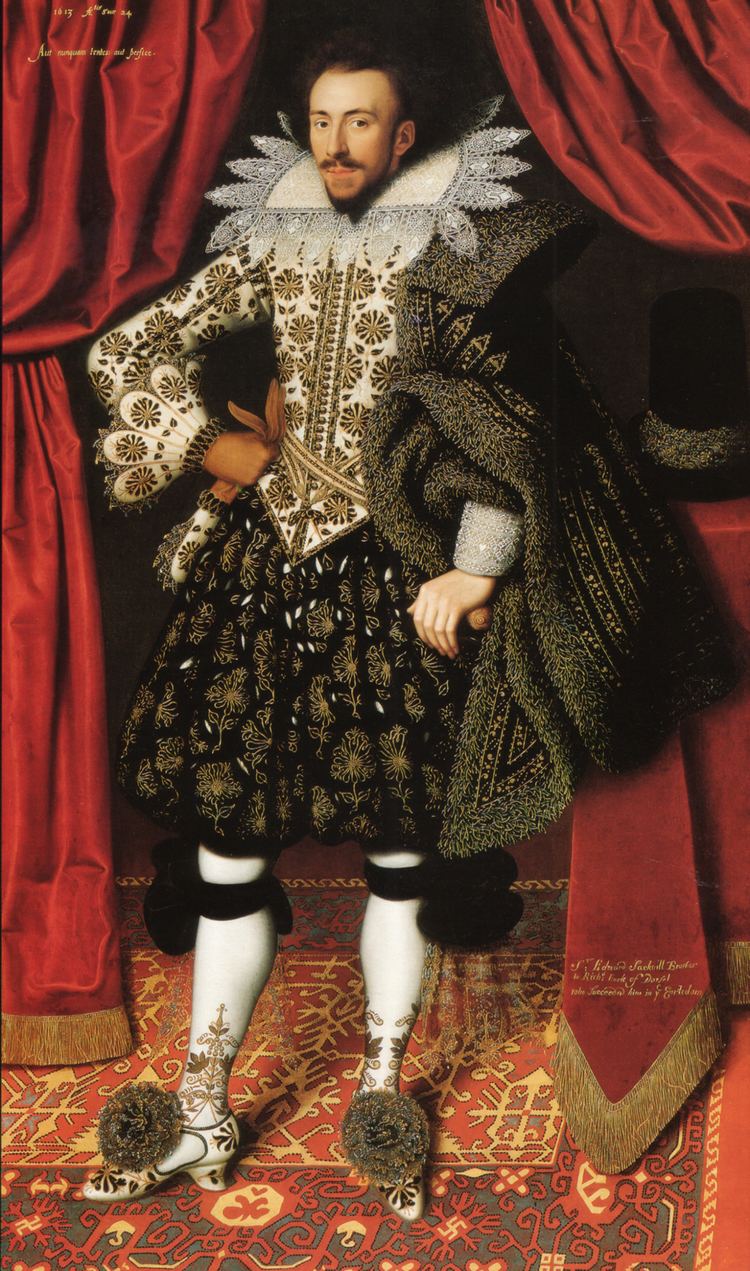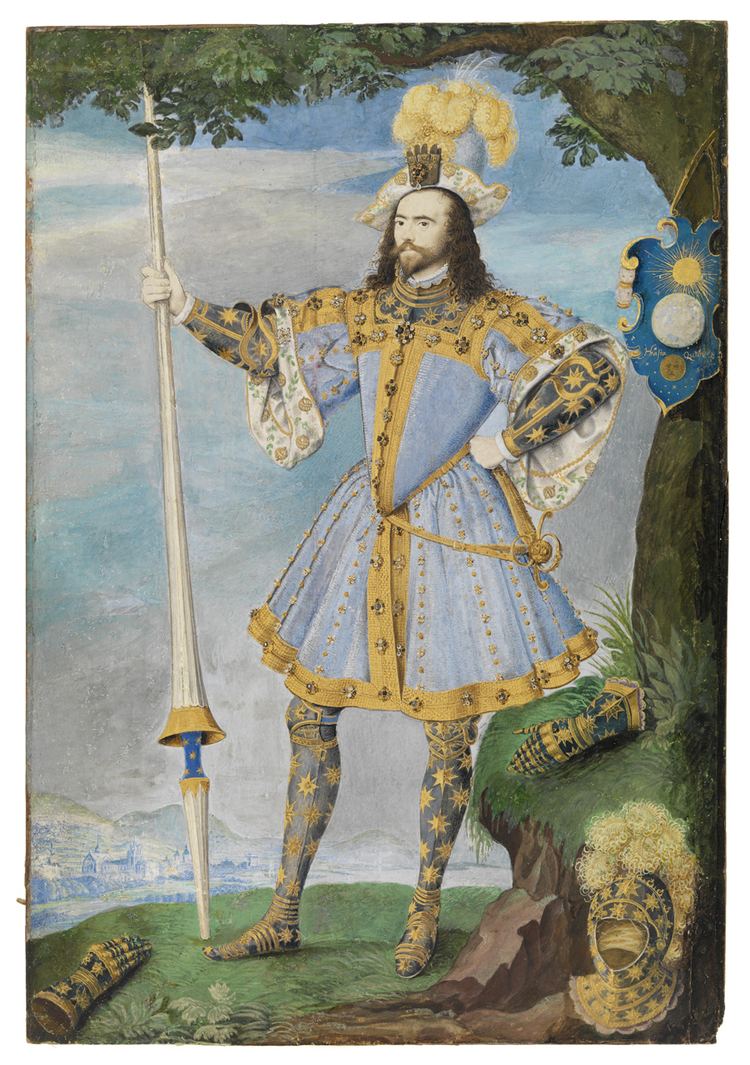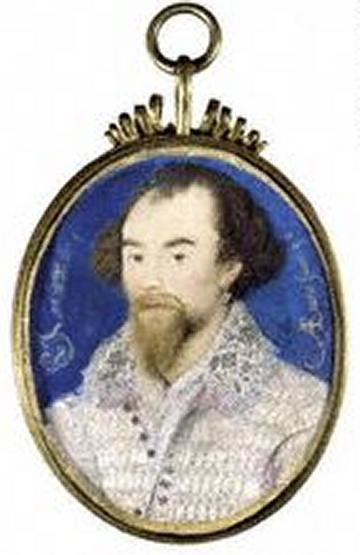Name George 3rd | Role Military Commander | |
Died October 30, 1605, Middlesex Children Lady Anne Clifford, 14th Baroness de Clifford Parents Anne Dacre, Henry Clifford, 2nd Earl of Cumberland Siblings Francis Clifford, 4th Earl of Cumberland, Margaret Stanley, Countess of Derby Cousins Anne Dacre, Countess of Arundel Similar People Lady Anne Clifford - 14th Baro, Margaret Clifford - Countess, Ferdinando Stanley - 5th Earl o, Charles Brandon - 1st Duke, Mary Tudor - Queen of | ||
Sir George Clifford, 3rd Earl of Cumberland, KG (8 August 1558 – 30 October 1605) was an English peer, naval commander and courtier of Queen Elizabeth I. He was notable at court for his jousting, at the Accession Day Tilts, which were highlights of the year at court. Two famous survivals, his portrait miniature by Nicholas Hilliard (c. 1590, now National Maritime Museum) and a garniture of Greenwich armour (now Metropolitan Museum of Art) reflect this important part of his life. In contrast, he neglected his estates in the far north of England and left a long succession dispute between his heirs.
Contents
- Early life and wardship
- Life at court
- Queens Champion and KG
- Naval career
- Marriage children and succession dispute
- Death and burial
- Suit of Armour
- In literature
- References

Early life and wardship

Clifford was born on 8 August 1558 at Brougham Castle in Westmorland, the son and heir of Henry Clifford, 2nd Earl of Cumberland (died 1570).

The Barons de Clifford, a junior branch of the Clifford feudal barons of Clifford of Clifford Castle in Herefordshire, had established themselves in the late 13th century at Appleby Castle in Westmorland in the north of England;

His father died in 1570 when George was a minor aged 12. His valuable wardship and marriage was granted by Queen Elizabeth to Francis Russell, 2nd Earl of Bedford, KG (died 1585) who in 1577 married him off to his daughter Lady Margaret Russell (1560–1616).
Life at court
Life at court meant that George Clifford spent an increasing amount of time in southern England, away from his family's estates. As a result, Brougham Castle, one of his properties in the north, was neglected and abandoned. George's fellow courtier commented on his northern upbringing, writing to the steward of the Robert Devereux, 2nd Earl of Essex that he disliked George Clifford as "the rudest Earll by reson of his northerly bringen up".
Queen's Champion and KG
Clifford rose in the world as an accomplished jouster and became Queen Elizabeth's second Champion on the retirement of Sir Henry Lee of Ditchley. A portrait miniature by Nicholas Hilliard circa 1590 commemorates the appointment, showing him in tilting attire with the Queen's glove pinned to his hat as a sign of her favour. She made him a Knight of the Garter in 1592 and he sat as a peer in the trial of Mary, Queen of Scots. Clifford was involved in the formation of the East India Company.
Naval career
He commanded the galleon Elizabeth Bonaventure in the Anglo-Spanish War of 1585, during which he had little success but fared better in later naval battles against the Spanish fleet in the Caribbean. He led and invested in a number of expeditions but many were turned back due to storms or lack of prizes. His first success was an expedition to the Azores in 1589 taking a number of Portuguese and Spanish prizes. He helped to prepare an expedition with Walter Raleigh which led to the Battle of Flores in 1592 and the capture of richly laden carrack Madre de Deus off Flores in the Azores. At the end of 1593, Clifford financed three ships for a further expedition to the Azores, which resulted in the Action of Faial between the English and a joint Iberian/Portuguese fleet.
He commissioned the building of his own ship, the 38-gun Scourge of Malice. During the Battle of San Juan in 1598 he achieved fame for having briefly captured Fort San Felipe del Morro, the citadel protecting San Juan, Puerto Rico. Clifford and his force of men had arrived in Puerto Rico on 15 June 1598 but by November of that year had fled the island due to harsh civilian resistance. All the great wealth he gained from his buccaneering he lost in jousting and horse racing and was eventually obliged to sell his inherited lands.
Marriage, children and succession dispute
In 1577 George married Lady Margaret Russell (1560–1616), a daughter of his guardian Francis Russell, 2nd Earl of Bedford, who had acquired as well as his valuable wardship, the right to marry him off to whomsoever he chose. By his wife he had children:
The Great Picture is a large triptych group portrait measuring 8ft 5" high and 16ft 2" wide, commissioned in 1646 by Anne Clifford, attributed to Jan van Belcamp (1610–1653). It formerly hung in Appleby Castle and is now displayed in the Abbot Hall Art Gallery, Kendal, Cumbria. It depicts Anne as a girl at left and as a mature woman at right. The central panel shows her parents and young brothers. The painting is replete with significant elements referring to her life and to her succession to her paternal inheritance, gained after a lengthy legal dispute, only settled in 1617. The House of Lords postponed the hearing of the matter of the barony, which remained dormant until 1678, when Nicholas Tufton, 3rd Earl of Thanet, was allowed to claim the peerage and became the fifteenth Baron de Clifford.
His two sons, Robert and Francis, had both died young before the age of 5, thus his daughter and only surviving child Anne Clifford became his sole heiress. She inherited the title Baron de Clifford suo jure, which having been created by writ in 1299 was able to descend in the female line. She also inherited £15,000. The vast majority of his estate however he bequeathed to his brother Francis Clifford, 4th Earl of Cumberland, who also inherited the earldom, which by the letters patent of its creation was precluded from passing to a female, as was usual. After lengthy litigation Anne won much of the land, including Brougham and Appleby castles.
Death and burial
Clifford died on 30 October 1605 within the Liberty of the Savoy in London. His chest tomb monument survives in Holy Trinity church, Skipton, adjacent to his seat of Skipton Castle. It is profusely decorated with heraldry, showing the arms of Clifford quartering Vipont (Gules, six annulets or 3,2,1), (feudal barons of Appleby, from whom the Cliffords inherited Appleby Castle and vast estates in Westmorland) impaling the arms of Russell as well as the wives of George's paternal predecessors: Beauchamp, de Roos, Percy, Dacre, Berkeley, Neville, etc.
Suit of Armour
George Clifford's tournament armour survives and is considered the finest surviving garniture of the Tudor period. As Queen's Champion Clifford's armour would have been unrivaled in beauty. It was made at the Greenwich armoury established by King Henry VIII, and a drawing of it is included in the Jacob Album, a book of designs for 29 different armours for various Elizabethan gentlemen. Clifford's armour, being part of a garniture, includes many pieces of exchange, including a grandguard, an extra helmet, a shaffron and several lance guards. These extra pieces allowed the wearer to modify his armour for different forms of tournament combat.
The armour is of blued steel and is etched and inlaid with elaborate gilded designs, incorporating columns of alternating fleurs-de-lis and Tudor roses, with the letter E for Queen Elizabeth I. It is on display in the Armor Court at the Metropolitan Museum of Art in New York, next to the two suits of armour of Sir James Scudamore which were also made at the Greenwich armoury.
The design of the New York armour is very different to the one he wears in the famous full-length portrait miniature by Nicolas Hilliard, which Hilliard perhaps invented.
In literature
In Virginia Woolf's novel Orlando: A Biography, the "Earl of Cumberland" discovers Orlando and his lover asleep amongst his cargo and believes them to be ghosts sent to punish him for buccaneering. In his terror the Earl vows to mend his ways and, in repentance, founds a row of almshouses. Although not explicitly stated, the Earl referred to must be the 3rd Earl, due to the relevant action in the novel occurring shortly after the death of Queen Elizabeth I.
